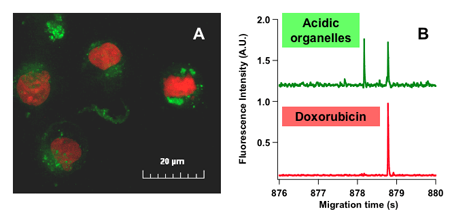
Recent Research Developments
Scientists have speculated that acidic organelles (lysosomes and endosomes) sequester drugs that are weak bases (e.g. doxorubicin, pKa ~8.4) because they become protonated when they enter the lumen of an acidic organelle (e.g. pH < 6). If this process occurs in a cancer cell, the acidic organelle contributes to eliminate the drug from this cell, which ultimately leads to the cellís survival and cancer drug resistance.
In a recent accelerated article published by Analytical Chemistry (77, 2281–2287, 2005), Yun Chen, Richard Walsh and Edgar Arriaga report on the detection and quantification of the anticancer drug doxorubicin in individual acidic organelles. The investigators used as models human leukemia cell lines that engulf (endocytose) fluorescently-labeled nanospheres into acidic organelles and then treated these cells with doxorubicin. Using confocal fluorescence microscopy, the investigators were able to identify the position of acidic organelles (Green domains in Figure 1A), but doxorubicin (red domain in Figure 1A) did not colocalize in acidic organelles and was mainly localized in the nucleus.
In contrast, when these researchers used capillary electrophoresis with laser-induced fluorescence detection (CE-LIF) they were able of separating and detecting individual events associated with acidic organelles containing doxorubicin (e.g. event detected simultaneously in the two channels of the LIF detector, Figure 1B) and other acidic organelles that did not contain doxorubicin (e.g. event detected only in acidic organelle channel). After calibration of this detector, they found out that on average acidic organelles contain ~ 10-20 mole doxorubicin per organelle. This is the lowest measured amount of a fluorescent drug associated with acidic organelle sequestration.

-
Figure 1. (A) Composite confocal image of CEM/C2 cells. Red and green indicate doxorubicin in the nucleus
and nanospheres in acidic organelles, respectively. (B) Electropherogram region showing acidic
organelles with and without doxorubicin isolated from CEM/C2 cells. Acidic organelle (i.e. nanosphere) detection, at
510 ± 20nm. Doxorubicin detection at 635nm ± 27.5nm. Separation was performed
at –300V/cm in sucrose-HEPES buffer. Cells were incubated with 50-nm
diameter nanospheres for 48 h and 25 µM DOX for 15 min
Next scheduled update: May 11th, 2005.
Copyright 2005 by the Regents of the University of Minnesota.For questions or comments, contact the Chemistry Webmaster or read the University's Online Privacy Statement.